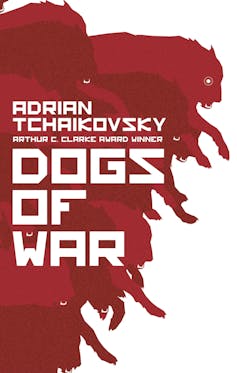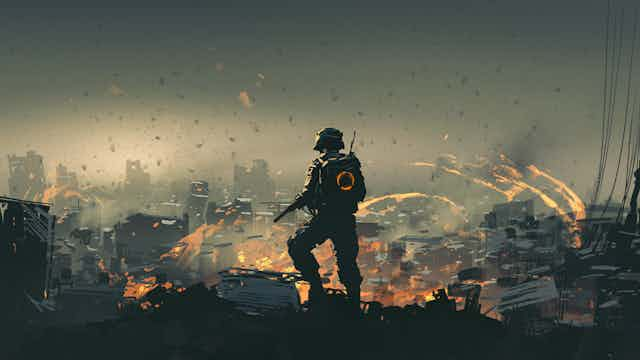From high-tech fighting machines to supercomputers and killer robots, science fiction has a lot to say about war. You might be surprised to learn that some governments (including the UK and France) are now turning their attention to these fantastical stories as a way to think about possible futures and try and ward off any potential threats.
For many years now, science fiction writers have made prophesies about futuristic technologies that have later become a reality. In 1964, Arthur C. Clarke famously predicted the internet. And in 1983, Isaac Asimov predicted that modern life would become impossible without computers.
This has made governments take note. Not only can science fiction help us imagine a future shaped by new technologies, but it can also help us learn lessons about potential threats.
There are many issues that science fiction engages with, which will no doubt be feeding into defence research around warfare and ways to mitigate risk. While we can never predict the future completely, we can only hope that our leaders and decision-makers learn lessons alluded to in science fiction, so that we may avoid the dystopia that some science fiction suggests.
Here are four issues from science fiction that governments may be considering.
1. Super soldiers
Super soldiers are a major theme in science fiction and take many forms. Often they are “super” on account of their technology, such as in Robert A. Heinlein’s Starship Troopers (1959) and Joe Haldeman’s Forever War (1974). However, more modern examples also explore how super soldiers can be further augmented with stronger muscles and even extra organs.
These super soldiers are stronger, faster and better able to wage war so there are, unsurprisingly, often many moral and ethical consequences to their role. The battle computer in Forever War has the power the blow up any soldiers that don’t follow orders.
Meanwhile, in the popular story-driven game Warhammer 40,000, monk-like warriors are implanted with a second heart, a third lung and a whole host of additional implants to help them survive on the field of battle. Known as Space Marines, they are changed to such an extent that they lose touch with the very things that made them human in the first place.
2. Drones
Drone operations play an increasingly important role in modern warfare, with the US and its allies making use of Predator and Reaper drones to patrol the skies and kill terror suspects from afar. More recently, we have seen examples of naval drones being used in the war in Ukraine.
But, of course, science fiction has long predicted this type of warfare and if anything, it is simply a logical continuation of the computerisation of daily life.
In Orson Scott Card’s novel Ender’s Game (1985), the child protagonist Ender Wiggin is taken into Battle School where he takes part in a series of elaborate military exercises using computers to simulate a war against a distant alien foe. Only after destroying the alien home world does Ender then discover that he wasn’t playing a game at all, but rather commanding real-world forces fighting in outer space.
In a recent article, I argue that Ender’s Game both pre-empts and engages with many of the key debates that we are having in this area today. This includes the way targets are selected and the moral and ethical questions around remote killing. As drones become more common in daily civilian life, these issues will only become more pressing.
3. Bio-engineering
Beyond drones and advanced computer technologies, we might also consider the biological sciences and the role of animals used to support humanitarian operations in war.
In Adrian Tchaikovsky’s Dogs of War (2017), the protagonist is a bio-engineered dog – quite literally, a dog-of-war (a mercenary) – who follows orders without question until one day discovering that his masters aren’t quite the “good guys” they first claim.

As with so many of the best works of science fiction, Dogs of War poses many ethical and moral questions about the human condition, including the way humans so often exploit others, and how animals then fit within our moral framework.
For example, the real-world case of the dog Kuno who saved soldiers’ lives in Afghanistan and was awarded the dog equivalent of the Victoria Cross. If we are to send out animals into dangerous situations to support soldiers or search for earthquake survivors then perhaps the animals too need to be augmented to reduce risks and make them better at what they do?
4. Behavioural modification
Science fiction has a lot to say about drugs and the way chemicals can be used to distort reality and modify behaviour. Perhaps the most famous author in this area is Philip K. Dick, with novels such as The Three Stigmata of Palmer Eldritch (1964), Ubik (1969) and Flow My Tears, the Policeman Said (1974) dealing with variations on this theme.
There was also the film Serenity (2005) (and its sorely missed TV series, Firefly), in which Captain Malcolm Reynolds and his crew travel to the planet Miranda to discover the dark consequences of drugs used to control populations and make people more compliant.
While these examples may seem sinister, they are nothing compared with the experiments conducted by the real-life CIA.
Towards the end of the Vietnam war, revelations emerged that the CIA had been conducting illegal human experiments in order to develop drugs for brainwashing and torture. This operation, known as MK-ULTRA, was made public at a senate hearing in 1977.
While we can only hope that such extreme and horrific experiments are a thing of the past, the concept of behavioural modification is still a big thing in defence research, though perhaps not to the same extent as it was in the middle of the last century.
Indeed, many would argue that social media is now a global battlefield, with information warfare a real threat to security, and the likes of Russia and China accused of waging cyber campaigns against the west.

